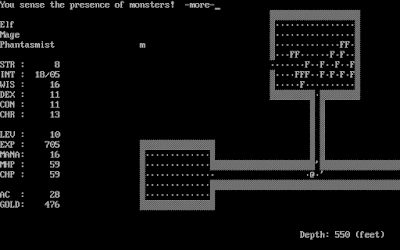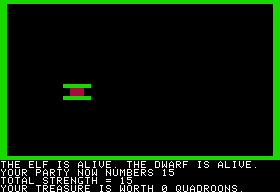 |
| The stats and gear that allowed me to survive level 36 |
Moria
encourages, and perhaps demands, a slow, methodical, cautious game.
This is, of course, impossible in the original Rogue, where hunger and
finite resources compel you to keep moving into deeper, more dangerous
territory, and games rarely take more than an hour or two before your
almost inevitable demise, which is made less painful knowing that your
subsequent retry will likely play differently enough to feel like a new
experience.
In Moria, you can spend more than an hour exploring a single dungeon floor, and once you're rich enough to buy scrolls of word-of-recall with monsters' pocket change, you can repeat these floor indefinitely - you buy two (or three) scrolls in town, use one to return to the dungeon where a brand new level full of more mazes, monsters, and loot is generated for you, and use the second when you want to return to town, whether it's to avoid trouble or to repeat the loop all over again.
I'd been repeating stages quite a bit lately - as conservatively as I'd been playing, perhaps it wasn't quite conservative enough. Level 36 seemed like a huge difficulty leap after a series of fairly untroublesome and equally unrewarding runs at levels 31-35. Monsters posed little threat as long as I played carefully enough to avoid getting mobbed and made sure to recover mana at every opportunity, but experience yields were slim, and my character had only leveled once during this period, reaching 27. Had I simply been lucky/unlucky in only encountering easy monsters for this phase, and consequently reached level 36 underleveled? The recovered loot hadn't been great either; although I could identify things with magic and no longer needed scrolls, my mediocre strength meant I couldn't even pick up most of the weapons and armor drops. Money wasn't a problem, but shops in town didn't sell anything suitable as permanent gear/stat upgrades except for scrolls of enchant weapons/armor, and I was getting to the point where those were beginning to fail. The loot drops I prized most were potions that granted permanent stat upgrades, but these were rare.
I did, eventually, manage to clear out a dungeon 36 levels deep. I mentioned in my last post that Gray Wraiths are bad news that can drain your levels on touch and drain your mana from far away, and I did encounter one, but managed to approach it from the opposite end of a long, straight corridor and with a full mana bar, where I could blast it to bits with a few well-placed Fire Bolts without suffering its draining touch. I graduated down to level 37, but still had to wonder if this was wise - was I really ready, or had I just barely survived the one before it? Impatience, and the safety net of a daily backed-up save, propelled me forward.
I had a few stock fighting strategies, depending on the encounter.
- Kill with multiple casts off Fire Bolt. If the monster survives after I run out of mana, finish it off with melee or wand magic.
- Damage
with one cast of Fire Bolt, and then send it away with Teleport Other
and rest. The spell itself has a high failure rate, but when it
succeeds, monsters never seem to resist it. But monsters may simply be teleported into the next room, so this strategy can still fail.
- Slow
Monster makes most monsters helpless in melee, but they often resist the
spell. You're lucky if you get a successful cast on a full bar of mana,
but one success is all you need.
I had learned that it's okay to cast emergency spells on an empty mana bar, namely Teleport and Teleport Other, if it will save your life. You'll faint and possibly lose a constitution point, but if you live, you can recover with a potion.
There were problems that forced retreats when they didn't kill me outright:
- An invisible wraith in a corridor drained my levels and seemingly couldn't be targeted by any of my spells. This could be remedied with a scroll of restore life, but still, I found no good way of dealing with it except for retreating and regenerating a new level.
- Lesser vampires/wraiths/wights normally shouldn't have been problems, as you can just run away and fire spells backwards whenever you gain some distance. But occasionally a spell would fail, and when this happens it fails before you tap a direction and not afterward, and I'd unthinkingly tap a direction anyway and then walk right into its draining reach.
- Invisible summoners are still big problems. One even summoned dragons, which are difficult enough to fight one-on-one, and completely unreasonable when a mage that you can't see or fight keeps spawning more monsters. I escaped by running through a corridor and casting Sleep on a weaker monster, blocking off everyone else and using word-of-recall to flee.
- Emperor Wights are like other kinds of wights, except tougher, meaner, and instead of being slightly slower than you, they're much faster than you, making the retreat-and-cast strategy untenable. I escaped one's multi-hitting death touches by casting self-teleport and then reading a recall scroll.
- Mature Dragons, like Young Dragons, can be slowed, but they'll just kill you with their breath which is more frequent and deadlier. I have found no reliable method for escaping them, let alone killing them.
- Some invisible thing gazed at me and drained my levels very quickly. At this point I had bought a Staff of Detect Invisibility, but it really didn't help. I'd use it, see the thing's position, and then it would move somewhere and gaze at me some more, from a new unknown position.
I eventually cleared a level 37 without any bad encounters and also without leveling or meaningfully improving myself except for some experience gains.
On level 38, I found:
- Ancient Dragons, who are even stronger than Mature Dragons, and worst of all faster than you. Detect Monster shows them as a capital D, and if you see them it's better to recall right away than risk having one chase you.
- An invisible summoner that turned out to be a capital W embedded in a wall when revealed with a magic staff. I still couldn't find any way to fight it.
- Emperor Liches. Everything bad about the undead but worse, and if I'm not mistaken fast too.
- More invisible things that drain stats, levels, etc.
After numerous failed attempts with no meaningful gains, and quite a bit of irreversible acid damage to my armor, I decided to try a new approach. I needed better gear, and I'd buy scrolls of Detect Object to find stuff lying around, while using Detect Monster to spot dragons and other things that I didn't want to deal with. This wouldn't help me avoid invisible stat-drainers, but for that I had Recall and restoration potions.
I stealthily went down to level 40, which seemed like a nice round number for a dungeon to farm. One of the first things I found this way, which still took several runs, was a much-needed potion of strength. It wasn't much, but it helped a little bit with carrying more stuff. Some hours later, I found a far more badly needed ring of Detect Invisibility, not by Detect Object, but by killing an evil mage that was guarding a cache of other things which turned out to be useless.
With this trinket I could finally see my translucent tormentors.
- Ghosts and banshees are horrible. They drain levels and intelligence with multi-hitting attacks, and their gaze causes fear. And you can't outrun them, because they move twice per turn, they can pass through walls, and teleport. Thanks to my ring, instead of being a menace you can't see, they're a menace you can't fight or evade.
- The invisible,
wall-embedded summoner I fought before was a Nether Wraith. Being stuck
inside a wall makes them semi-invincible sources of unlimited monsters,
which really bites.
- Several standard enemies like giant ants and centipedes come in invisible varieties. With the ring, they become "clear" instead of invisible, and are otherwise unremarkable.
- Quasits
aren't too bad. Before I had the ring of invisibility, they were
dexterity-draining nuisances who could be eventually killed by stabbing
int he dark. With the ring I could target them with spells before
suffering stat drain.
Some of my routs and deaths:
- A sorcerer ate several Fire Bolts, draining my mana, and then summoned a Young Multihued Dragon, which finished me off with a breath attack of some kind.
- While waiting to recharge mana from a fight, a Mature Dragon walked into my corridor. I teleported it away. I rested again, and it walked right in. I teleported it away again, rested again, and this time an Emperor Wight spawned in the room south of the corridor, where I had already explored, forcing me to run to the north. As I ran to the north, being hit several times by the Emperor Wight's life-draining hit, I ran into the dragon.
- A Nether Wraith teleported right in while I was resting, drained my levels, and frightened me. As I ran, it teleported in front of me, and a throng of Dragon bats swooped in from behind. I had no means to fight, but enough HP to survive long enough to Recall out.
- Recall took me into a room full of Dragon Bats and one humanoid who turned out to be a Ninja. After I exhausted my mana, the Ninja hit me repeatedly draining my strength down to the point where I was useless.
- An Ancient Multi-Hued Dragon just outside the range of Detect Monsters wandered into the room I was exploring.
After a good day of running level 40 and usually returning in worse shape than I had left it, my only real gains being a potion of Constitution, I decided to be reckless and head for level 50 in the hopes of better treasure, and perhaps a look at the Balrog. I was perfectly aware that this tactic would be suicide if I weren't using backups, but that ship had sailed long ago. Reaching level 50 wasn't too difficult between my spells that revealed staircase locations, spells that revealed monsters, and spells that dug tunnels, but it still took a few tries. There were some mishaps from nastier monsters slipping past my magical reconnaissance, especially invisible ones which are not revealed by magic even with the Detect Invisibility ring, though none fatal.
The Balrog was on level 50, alright. I went in a few times, came back empty handed usually, but in one run, I self-teleported right onto him. And he utterly stomped me.
Here, I also sometimes found Evil Iggy, an obnoxious, nigh-invulnerable thief who had a penchant for stealing things from my pack and disappearing in a puff of smoke.
What I didn't find, at least not for awhile, was any good loot. The manual mentions "ego" weapons with amazing powers, and also mentions armor with elemental resistance. So far I haven't found either, nor have I found any rings or amulets with properties I haven't already encountered on earlier floors, or any more potions of Restore HP or Healing or powerful scrolls like Genocide. I did, after at least ten fruitless runs, locate another potion of strength, and a potion of experience which granted tens of thousands of EXP and took me straight to level 30, but this has hardly been the lootfest that I was hoping for. The stores haven't stocked anything new either.
How are you actually supposed to beat this game?































